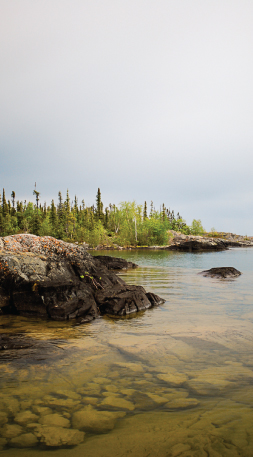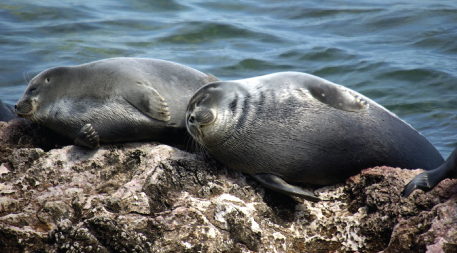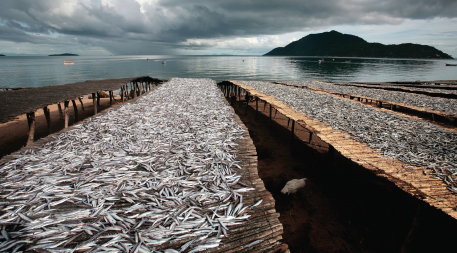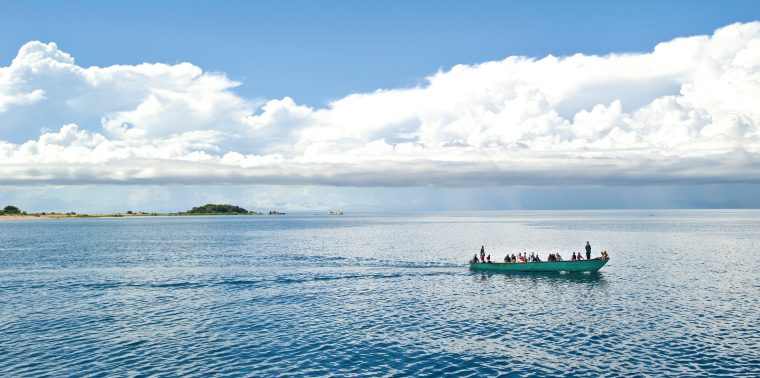December 23, 2013 — The first time aloft over the Canadian North offers an unforgettable sight: Thousands of lakes filling the raw scars of recent glaciers, shimmering in the slanting subarctic light. It’s an astounding abundance of water.
Yet if you were to add these hundreds of thousands of lakes to hundreds of thousands of other lakes in northern Europe and Asia, and combine them with the millions of miles of streams and rivers in the world (even the Amazon and Nile and Mississippi), and all the glacial meltwaters and every wetland — if you were to add up all that liquid freshwater, it would only be half the amount contained in the world’s 10 largest lakes.
These great lakes — Baikal in Asia; Superior, Michigan, Huron, Ontario, Great Bear and Great Slave in North America; and Tanganyika, Malawi and Victoria in Africa — contain the vast volume of the freshwater on Earth. And they provide for the needs of millions of people.
“Large lakes of the world are magnets for human population. We’re drawn to the lakes for easy access to freshwater, we’re drawn to them for their aesthetic beauty, we’re drawn to them for their fish, we are drawn to them for their transportation services,” says Tom Johnson, founder of the Large Lakes Observatory at the University of Minnesota Duluth.
Big as they are, these lakes are not immune to harm. Many have already suffered overfishing, the Fortunately, as human pressures increase, our understanding of large lakes is increasing as well. And lessons learned on one continent can help solve problems on another.introduction of exotic species, industrial pollution, and algae blooms and other signs of nutrient inflow from deforestation, agriculture and sewage disposal. And, of course, climate change. All these influences stand to impair the gifts these large lakes provide.
Fortunately, as human pressures increase, our understanding of large lakes is increasing as well. And lessons learned on one continent can help solve problems on another. Researchers studying large lakes around the world share insights pertinent to management, whether it is mitigating the damage of invasive species in U.S. Great Lakes, protecting a rare freshwater seal from industrial contamination of Lake Baikal, or balancing concerns of biodiversity with the needs of African fishermen.
What’s So Special?
The world’s largest lakes work much like its smallest. The same laws of physics, the same rules of chemistry apply. Sunlight penetrates surface waters, stimulating the growth of rooted plants and free-floating plankton. These are eaten by zooplankton and other tiny herbivores, which are eaten by larger invertebrates and fish. Lakes are warmed by sun, cooled by evaporation. Wind and waves mix their waters and impart currents. Inputs of nutrients increase productivity and turbidity.

Canada’s Great Slave Lake, like all large lakes, provides life support to a spectrum of unique natural communities. Photo by cfournie (Flickr | Creative Commons).
From a great lake to a small pond, the processes are remarkably similar, says Sally MacIntyre, a physical limnologist and oceanographer at the University of California, Santa Barbara. “You can use those little lakes as laboratories to understand the big ones.”
As size increases, however, so does time. “Residence time” — the time it takes for inflow and outflow to theoretically replace all water in a basin — can run to four centuries in a huge, deep lake such as Baikal or Tanganyika. An oil spill in Baikal, with no known oil-eating microbes, would linger for decades.
Yet scientists are sometimes surprised.
“We used to think that in large lakes changes happen more slowly because they were such large systems. We’re finding that that is not always the case,” says Norine Dobiesz, research associate with the LLO. The proliferation of nonnative filter-feeding zebra and quagga mussels in Lake Huron has apparently undermined the food chain, causing a swift crash of exotic alewives and Chinook salmon. “So it’s making people rethink how fast these large lakes can react,” says Dobiesz.
The world’s great lakes have large size in common. But they also have important differences.
The world’s deepest lakes have formed in geologic faults, or “rifts.” These include Lake Baikal in Siberia, more than a mile deep with a fifth of the world’s freshwater (twice Superior’s volume and four times its depth). Lake Tanganyika, largest of the so-called rift valley lakes in East Africa, is nearly as voluminous. Moreover, these lakes are old — 30 million years for Baikal, 20 million for Tanganyika. With a long history of evolution, they’re home to species found nowhere else. Baikal has 2,500 endemic species. Of its 29 species of sculpins, a deepwater fish, 27 are endemic. Baikal even has a unique freshwater seal.

The Lake Baikal seal, Pusa sibirica, is the only exclusively freshwater seal. Some 80,000 to 100,000 seals are thought to live on or near the big lake. They are found nowhere else in the world. Photo by Sergey Gabdurakhmanov (Flickr / Creative Commons).
Large North American lakes, scoured out by glaciers, are comparatively shallow (though Great Slave, the deepest of the lot, reaches to more than 2,000 feet). They are also young, dating to the retreat of the big ice scarcely 10,000 years ago. Most are connected by rivers to nearby lakes. As a result, their species, from diatoms to predatory fish such as lake trout, are widespread.
Big differences also exist between northern and tropical lakes. In temperate climes, cooling water sinks toward the bottom as it reaches its greatest density just above freezing temperature, bringing oxygen to the depths and forcing nutrients to the shallows. Tropical lakes stratify — warm water on top and cool dense water below. Wind mixes the layers but never to great depths. As a result, deep water in these lakes is devoid of oxygen and most life.
Valued by Millions
The world’s great lakes provide valuable services to the millions who live nearby. Companies locate on the shores of the North American Great Lakes for a supply of clean water. The lakes have important fisheries (though recreational fishing has far surpassed commercial fishing). They provide low-cost transportation of taconite and grain. They influence the region’s climate, boosting snowfall to the ski hills of Michigan’s Upper Peninsula and moderating the climate of the cherry- and grape-growing Michigan Mitten.

Nearly three football fields long, the Lee A. Tregurtha is one of more than 100 lake freighters, or “lakers,” that carry iron ore, grain and other goods among the ports lining the North American Great Lakes. A laker can carry a ton of cargo 600 miles on a single gallon of fuel. Photo by P. Gordon.
“One of the things about the Great Lakes is that they are used for so many different industries,” says Lynn Vaccaro, coastal research specialist for Michigan Sea Grant in Ann Arbor. In fact, Vaccaro has calculated that more than 1.5 million jobs are directly connected to the North American Great Lakes, generating $62 billion annually in wages. “The Great Lakes are used for so much more than just tourism and fisheries,” she says.
But if the North American Great Lakes are valuable, Africa’s great lakes are imperative to survival. The number of people who live near the African lakes and depend on them for food and employment is staggering. According to the United Nations, more than 30 million live in the Lake Victoria watershed, 10 million near Lake Tanganyika, and more than 10 million in the Lake Malawi catchment. These numbers are growing 2 to 3 percent per year.

Most of the animal protein consumed by people living along Lake Malawi’s shores comes from fish such as these native usipa. Photo by Alex Bramwell.
And these lakes mean everything to those who live near them. As one example, lakes Malawi (a deep rift lake with more than 1,000 fish species), Chilwa, Chiuta and Malombe provide food, irrigation, recreation and transportation to more than 13 million in Malawi, Tanzania and Mozambique, according to Daniel Jamu, senior scientist at the WorldFish Center in Zomba, Malawi. Fisheries employ 60,000, and an additional 450,000 work in fish processing, distribution and associated trades. Fish from these lakes supply Malawians 40 percent of their total protein.
“Fish is a critical ingredient for nutritional security in Malawi, where human diets are dominated by maize and cassava,” Jamu says.
Feeling the Strain
Big as they are, the world’s large lakes are not invulnerable. Dobiesz and colleagues identified 25 metrics — predator-prey balance, food-chain length, number of exotic species, phytoplankton abundance, pollutants and others — to establish trends and gauge the health of ecosystems for Baikal, the African rift lakes and the North American Great Lakes.
The healthiest of the big lakes Dobiesz measured were Tanganyika, Baikal and Superior — not coincidentally the lakes with smaller human populations. Lakes Malawi, Huron and Erie were in a middle, “transitional” group. At the “disturbed” end of the spectrum were Ontario, Victoria and Michigan.
In some lakes, industrial pollutants such as PCBs discharged in the water or deposited atmospherically accumulated up the food chain, reaching worrisome concentrations in top predators.
The force driving disturbance? “People,” sighs Dobiesz. “What we really found is it all starts with people. The metrics that changed the most and led to problems with other things were related to how big was the population around the lake.”
Dobiesz found the lakes had many problems in common. Overfishing drove down the average size of exploited species. Increasing nitrogen from fertilizer and other runoff fed harmful algae blooms. Shoreline development consumed fish nurseries and wildlife habitat.
In some lakes, industrial pollutants such as PCBs discharged in the water or deposited atmospherically accumulated up the food chain, reaching worrisome concentrations in top predators such as lake trout in North America or seals in Lake Baikal.
Some problems are unique to certain systems. Baikal and the African lakes have few problems with accidentally introduced species because they are not very connected to other lakes (if at all) and don’t support shipping from other lakes and foreign seas. But invading nonnative species have colonized North American Great Lakes, with sometimes disastrous effects. Sea lampreys entered through the Welland Canal in the early 1900s and decimated lake trout populations within years. Zebra and quagga mussels hitchhiked aboard the ballast tanks of ocean-going vessels. The filter feeders have helped clean up the waters, but have also disrupted food webs, leading to skinny, poorly conditioned whitefish, a valuable native species.
Dobiesz says her research has helped develop profiles of lake health based on commonly available metrics. These profiles will guide management and research and provide a good picture of changes in lake ecosystems over time.
Heat Wave
Arkady Kalikhman, a scientist who has kayaked Lake Baikal, says that for centuries the big lake has been an icon of “beauty, purity, grandeur and inaccessibility” to those who live around it.
“To my knowledge there’s no other natural resource in any other country for which an anthem has been written and all people in that country know or recognize that song,” says Marianne Moore, aquatic ecologist at Wellesley College and authority on Baikal. “The lake is a powerful symbol for Russians. It represents for them the unspoiled beauty of the Russian motherland — pristine wilderness.”
The sense of untrammeled nature, however, is belied by data emerging today from a remarkable trove of painstaking field observations gathered by three generations of a Russian family.
Limnologist Mikhail Kozhov directed the Baikal Biological Station at Irkutsk State University when he began sampling water in 1946. Taking a boat in summer and trudging over the ice in winter, he recorded water temperature and clarity and gathered samples from as deep as 2,600 feet. He laboriously identified hundreds of plankton species. Eventually, he was joined by his daughter, Olga Kozhova, and later by granddaughter Lyubov Izmestyeva.
The family’s records became known to non-Russian scientists only recently. “It’s extraordinary,” says Moore. “They sampled so frequently, every 10 to 14 days through all seasons of the year since 1946.”
A warming climate is expected to increase melting of permafrost in the watershed, releasing nutrients and increasing eutrophication.
The Kozhov data show Baikal has warmed, especially in summer. Ice covers the lake fewer days than in years past. And that does not bode well for the big lake. Earlier melting might threaten both endemic diatoms that proliferate under the early spring ice and the freshwater seal, which gives birth and shelters pups in ice caves on the lake. A warming climate is expected to increase melting of permafrost in the watershed, releasing nutrients and increasing eutrophication.
Higher temperatures will cause different problems in Africa’s great lakes. Warmer surface temperatures will intensify stratification. As a result, the oxygenated surface waters will become shallower; the anoxic depths, even deeper. The zone suitable for crucial fisheries will shrink.
It’s fair to say concern over the world’s great lakes won’t drive solutions to climate change. But concern over a changing climate makes other stewardship all the more important. “Climate change is likely to exacerbate some of the other environmental stressors facing that lake,” says Moore. So managers should try to minimize the others, such as reducing industrial pollution or eutrophication.
Razor Thin
Among the challenges that could magnify the threat posed to great lakes threatened by climate change is the growing — and sometimes conflicting — demand for the finite ecosystem services they provide.
Lakes maintain levels by a balance of inflow, evaporation and outflow. In Lake Malawi, the difference is razor thin: 85 percent of the inflow evaporates, leaving 15 percent to exit as the Shire River, tributary to the Zambezi. A little more evaporation, a little less rain, and the outflow ceases, says Johnson. Under such circumstances, he says, “the alkalinity of the lake goes up, the ecosystem changes dramatically because of that change in chemistry.” If climate change creates such alterations, Malawi, with the most diverse fish community on Earth, could lose some of its more than 1,000 species of sunfishlike cichlids.
“There are also implications for tourism. There are implications for fisheries in the lake,” says Johnson. “There are a lot of very complex questions to be addressed.”
Cooperation and Differences
International cooperation opens new vistas in the quest to protect the world’s great lakes. But International cooperation opens new vistas in the quest to protect the world’s great lakes.collaboration also reveals cultural differences among people who live by these lakes.
Consider Lake Victoria, bordered by Tanzania, Kenya and Uganda. Second-largest freshwater lake in the world by area — bigger than Lake Huron or Michigan — Victoria is only 260 feet at its deepest. It once had a tremendous number of cichlid fish species, many of which provided subsistence to the people on its shores. But none was large enough to support a commercial fishery. So during the 1950s, fish managers introduced Nile tilapia and Nile perch, a freshwater giant that can weigh more than 400 pounds. The effect on native cichlids was disastrous. With habitat changes, such as the spread of exotic water hyacinth across shallow bays, Nile perch and tilapia were blamed for the extinction of 150 species of cichlids. Says MacIntyre at UC–Santa Barbara, “It was considered one of the largest ecological catastrophes to ever happen.” The International Union for the Conservation of Nature has labeled the Nile perch one of the world’s 100 most invasive species.
Yet local residents see it differently. The two exotic fish support a commercial fishery that lands $590 million of fish a year, including the annual export of $250 million worth of Nile perch — and this in an area with an annual income of about $1,200, where the average fishing boat consists of a two-man canoe. Victoria fishing employs 2 million and provides household incomes to nearly 22 million. According to the Lake Victoria Fisheries Organization, “Lake Victoria is the most productive freshwater fishery in Africa … an immense source of income, employment, food and foreign exchange for East Africa.”
“On the African lakes fish production is everything,” says Dobiesz. U.S. biologists “look at the health of our systems as how well they mirror historic populations. In Africa, they consider healthy ecosystems to be ones that provide them with a lot of fish.”
Disregard for clashing perspectives can lead to the failure of aid and collaboration over the management of fish, lakes and other resources. As Dobiesz notes, some non-governmental organizations “exist solely through support of donors from outside of Africa who contribute financial assistance for specific community projects. Such groups can alienate the local community by ignoring social norms and traditional structures.”
Dobiesz recalls walking with a Ugandan researcher who was in the United States to help with the study of ecosystem health. At one point, Dobiesz explained the American conservation concept of catch-and-release fishing.
The Ugandan scientist stopped, dumbfounded. “I could never explain that to anyone in Africa,” she stammered. “No one would ever take the time to catch a fish and throw it back. If they didn’t need it for dinner, they would give it to someone who did. Or they would sell it to someone. But they would never, ever throw it back.”
If research will continue to inform and benefit management of the world’s big lakes, researchers will have to be keenly aware of the values and needs of the people living on the shores of those lakes.
![]()
A version of this feature originally appeared in the Fall 2011 issue of Momentum magazine, Ensia’s predecessor.
Ensia shares solutions-focused stories free of charge through our online magazine and partner media. That means audiences around the world have ready access to stories that can — and do — help them shape a better future. If you value our work, please show your support today.
Yes, I'll support Ensia!
